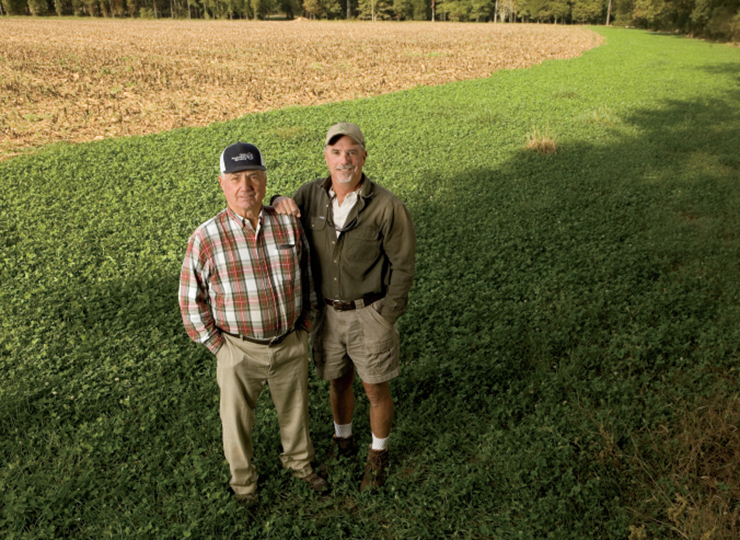Home > Virginia > Virginia Crops & Livestock > Virginia Row-Crop Farmers Still Growing Strong
Virginia Row-Crop Farmers Still Growing Strong
In partnership with: Virginia Department of Agriculture and Consumer Services

Charles City farmer David Black knows the importance of protecting the environment. He and his father, George, farm 1,300 acres of wheat, soybeans and corn on land that was once an American Indian village and one of the sub-tribes of the Powhatan Federation – the tribe of Pocahontas.
Black takes seriously the responsibility of nurturing this historical cropland that has been worked continuously for 400 years. Four centuries worth of turning the ground took a toll – evidenced by erosion and diminished top soil. In recent years, the Blacks were able to stabilize these conditions through some agronomic TLC and a generous helping of the latest expertise available to farmers.
Balancing Production with Environment
Virginia’s agriculture industry has advanced tremendously since the primitive methods of American Indians and the labor-intensive plantations. Mindful of preserving historically rich farmlands, Black and other state growers are integrating cutting-edge technology with sustainable practices.
At first, these two priorities might seem dualistic.
On the contrary, what’s good for the environment tends to enhance soil fertility. These Virginia farmers engage in a myriad of actions that benefit both their businesses and Mother Nature.
In fact, Virginia row crops have maintained high yields and quality, all while also turning attention to environmental sustainability. In 2011, Virginia’s four principal row crops – corn, soybeans, peanuts and cotton – were valued at $610.8 million, according to the U.S. Department of Agriculture.
Peanut harvest in 2012 was expected to grow to 66 million pounds, and cotton had a top quality year, based on staple length, according to Gail Moody Milteer, marketing specialist for the Virginia Department of Agriculture and Consumer Services.
The proximity of the cotton-growing region to the Norfolk port allows for easy exportation to countries like Turkey, Mexico and Vietnam, says Milteer. As for the two remaining crops, in 2012, corn producers anticipated picking 91 bushels per acre, totaling just shy of 32 million bushels statewide, as reported by USDA. About 18.4 million bushels of soybeans were expected to be harvested, over 540,000 acres.

This attention to both yield and the environment is made easier through new sustainability techniques. The primary sustainable technique Black uses is no-till cropping. This simple technique has dramatically halted the loss of top soil. As the name suggests, no-till disturbs the soil minimally.
“We started using it as a financial alternative,” Black explains, citing the labor savings generated from this zero-prep planting method. As time went on, the advantages bloomed prolifically, as did crop yields. “No-till helps with water retention, it increases organic matter and the number of earthworms,” he explains. “It cuts in half the amount of traffic on the field.”
These techniques require just three pieces of equipment throughout the season: a planter, a sprayer and a combine. Before, Black used to plow once, disk twice and then plant. Reduced traffic means labor and fuel savings, reduced emissions and fewer soil compaction issues.
“Approximately 600,000 Virginia grain acres are currently in ‘continuous no-till’ practice,” says Ben Rowe, communications director for the Virginia Grain Producers Association. “This practice has reduced soil erosion by 44 percent since the 1990s.”
“It’s a win-win for everybody. We are very close to a zero sediment loss,” Black adds. “The East cannot afford to lose any more top soil.”
Cover Cropping
Another conservation practice, cover cropping, has grown in popularity among Virginia farmers.
“Cover crops provide soil cover which helps prevent soil erosion and reduces leaching into groundwater,” Rowe says. “Cover crops improve soil fertility by adding organic matter and furnishing moisture. Certain cover crops can supply nutrients to cash crops and thus reduce purchased fertilizer inputs.”

Biotechnology Advances
Virginia growers take advantage of biotechnological advances like seed coatings. Compared to conventional seeds, Rowe cites biotech crop yields can be significantly higher and mature faster. Biotech seeds offer resistance to diseases, pests and drought. All this means fewer sprays and less fuel.
Rowe praises Virginia’s agricultural improvements over the last several decades. Using corn as one example, Rowe explains, “Thanks to innovative technology and improved seed, Virginia’s grain producers have improved their yields by over 100 bushels per acre since 1930 on over 20 percent less land. Since the 1980s, [they have] decreased fertilizer needed to grow a bushel of corn by 36 percent.”
Continuing his philosophy of proactive stewardship, Black employs biosolids. This soil amendment, Black explains, is highly economical, available, and part of a sustainable cycle. Black cautions there is a lot of misinformation about biosolids and that more education is needed.
“I am an ardent believer in it,” he says. Black applies biosolids to 90 percent of his acreage every three years.
“Because it breaks down slowly,” he explains, “it significantly reduces the need for commercial fertilizers.”
Looking forward, Black believes that “the next 10 years will be extremely interesting in our ability to improve the land. There are some cool, neat things with precision ag technology that are moving fast. The problem is, like a lot of things in farming, none of this happens overnight.”
One thing is certain: Black predicts continuing improvement of the land.
“It will be better when I leave it than when I found it,” he says.



